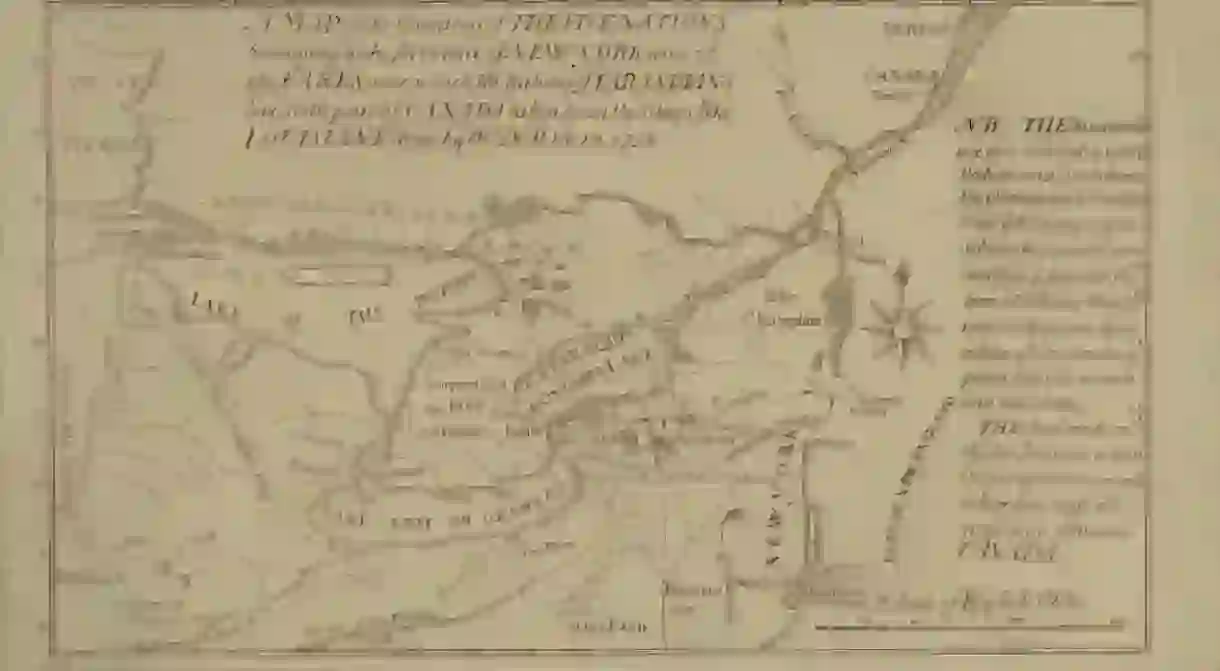A History of the Iroquois in Montreal

In the wake of the elaborate celebrations that filled the year 2017 for Montreal’s 375th anniversary, it’s important to recall that the city’s history didn’t start just under 400 years ago. Even prior to French settlement, the island that is now known as Montreal was absorbed into a long and complex history that involved the Iroquois, and that history subsequently intertwined with the presence of the European newcomers. Here’s a brief overview of the history of the Iroquois in and around Montreal.
Deep History & Geography
Prior to human settlement, the island of Montreal was created after Ice Age glaciers retreated from the region. There was an inland body of salt water, referred to as the Champlain Sea, that covered the area until around 12,000 years ago when it began to recede. The oldest traces of humans living on the island date back to about 4,000–5,000 years ago, and for thousands of years, nomadic peoples roamed the area.
The Iroquois
Around AD 1300, the evidence shows that some groups opted for a more sedentary life around what would later be the island of Montreal, as well as across other parts of the St. Lawrence River Valley. At the time of Jacques Cartier’s arrival in 1535, the St. Lawrence Iroquoians inhabited the island, in the village of Hochelaga. Through a series of political and cultural upheavals, along with warfare, the Haudenosaunee, or “people of the longhouse,” who are commonly referred to as Iroquois or Six Nations, emerged as the dominant Aboriginal nations in the area. They are members of a confederacy now referred to as the Haudenosaunee Confederacy.

Changing Social and Political Structures
Before European contact, the Haudenosaunee were horticulturalists, living year-round in villages made up of several hundred people. They were matrilineal, meaning that the basic unit usually consisted of the descendants of an individual woman. No one knows the exact founding date of the Haudenosaunee Confederacy, though it is most often claimed to be around the mid-16th century.
With the rise of the French-influenced fur trade during this period, the Haudenosaunee instigated successful military campaigns toward subjugating or dissolving neighboring Aboriginal groups. For example, the French-allied Huron-Wendat people were dispersed from their homeland in 1649, and many of them came to be adopted into the Haudenosaunee.
As the French negotiated trade and military alliances with many of the enemies of the Iroquois, the Haudenosaunee and New France were often at war. During periods of peace, some Haudenosaunee were converted to Catholicism and settled along the St. Lawrence.

Wars & Treaties
The European colonists and the Haudenosaunee established an alliance of “mutual non-interference” in the early 17th century, with the Two Row Wampum Treaty. There was also the Silver Covenant Chain, another agreement between the British Crown and the Haudenosaunee. Among other treaties, in Montreal in 1701, the Haudenosaunee signed a treaty with the French in order to secure peace among Aboriginal nations. Population losses caused by the combined factors of disease and war were considerable, despite the fact that the Haudenosaunee had absorbed large numbers of war captives and refugees. The Iroquois were deeply involved in subsequent wars, including the American Revolution and the War of 1812, fighting as allies and suffering losses throughout the region.

Contemporary Situation
Throughout the 19th and 20th centuries, the Canadian government’s implementation of restriction and assimilation policies negatively impacted the cultural and political foundations of the Haudenosaunee. At the same time, however, opposition and activism continue to be an important factor in the maintenance of strong community identity. Haudenosaunee communities such as Six Nations, Akwesasne (Mohawk) and Kahnawake (Mohawk) outside of Montreal are among the largest and most populous reserves in Canada. The Iroquois can also be found in Ontario and New York.

The nations that make up the Haudenosaunee Confederacy are Mohawk, Seneca, Oneida, Onondaga, Cayuga, and Tuscarora. You can find the legacy of the Iroquois in some of the variations of street and place names around Montreal, including the Hochelaga-Maisonneuve neighborhood.













